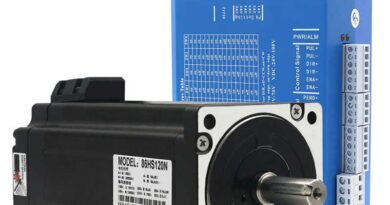Microstepping a Stepper Motor
Microstepping is a means of moving a stepper motor’s stator flux smoother than in half- or full-step modes, resulting in less vibration and noiseless stepping down to zero hertz as well as facilitating smaller step angles and better positioning.
A stepper motor is a brushless synchronous motor, meaning the stable stop position of the rotor is in synch with the stator flux. The rotor rotates with the rotation of the stator flux, which makes the rotor move toward the new stable stop position.
When you drive a stepper motor in half- or full-step mode the stator flux rotates forty-five and ninety electrical degrees respectively. The stepper motor develops a pulsing torque because the distance between the stator flux and the rotor position is not constant in time due to the stator flux’s discontinuous motion.
Because you only need two current levels — Ion and 0 — generating a stator flux that rotates forty-five or ninety degrees at a time is simple and can be accomplished with any stepper motor driver. When we combine the Ion and 0 values in the two windings we can create eight combinations of winding currents, giving us the eight typical one- and two-phase-on stop positions responding to the flux direction.
You can create a rotating flux capable of stopping at any desired electrical position if you use a stepper motor driver that can generate any current level from zero to one hundred forty-one percent of the nominal two-phase-on current of the stepper motor, also enabling you to select any electrical stepping angle. You can change both the direction of the flux and the amplitude.
Microstepping a stepper motor will cause the rotor to move much smoother on low frequencies because the stator flux, which controls the stable rotor stop position, moves more continuously than it would in half- or full-step mode.
Microstepping has a relatively minor effect on the rotor movement compared to full-stepping with frequencies above two to three times the stepper motor system’s natural frequency. This happens because of the filtering effect of the load and rotor inertia — a stepper motor system acts as a low-pass filter.

